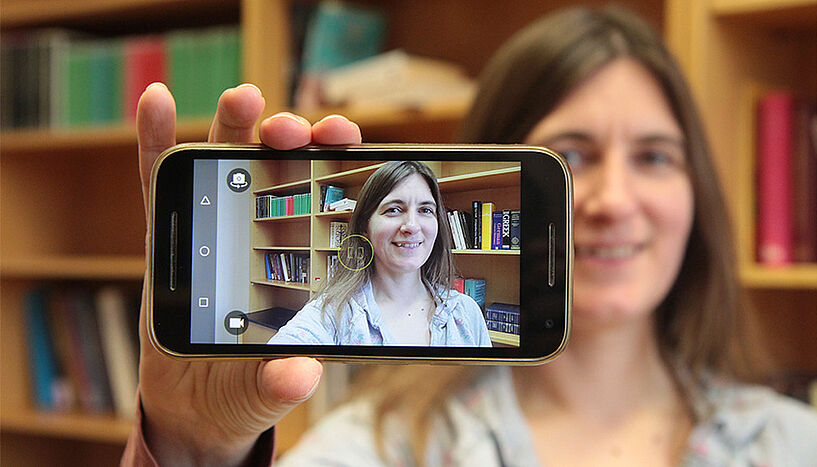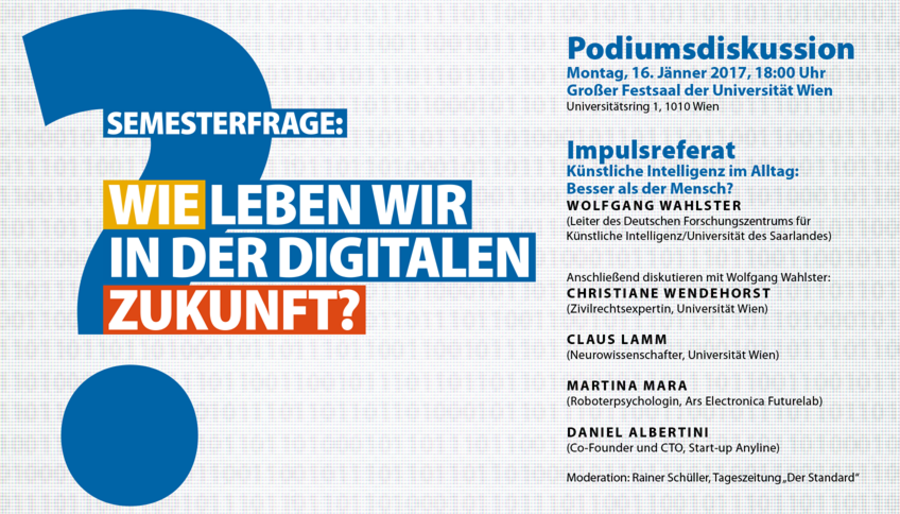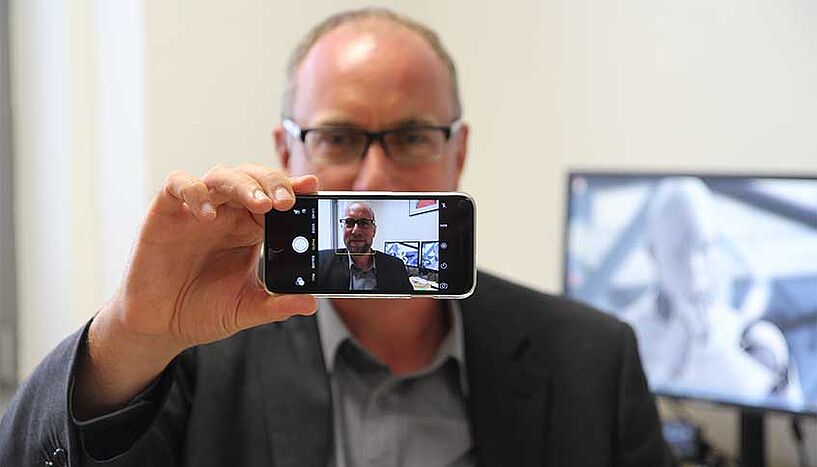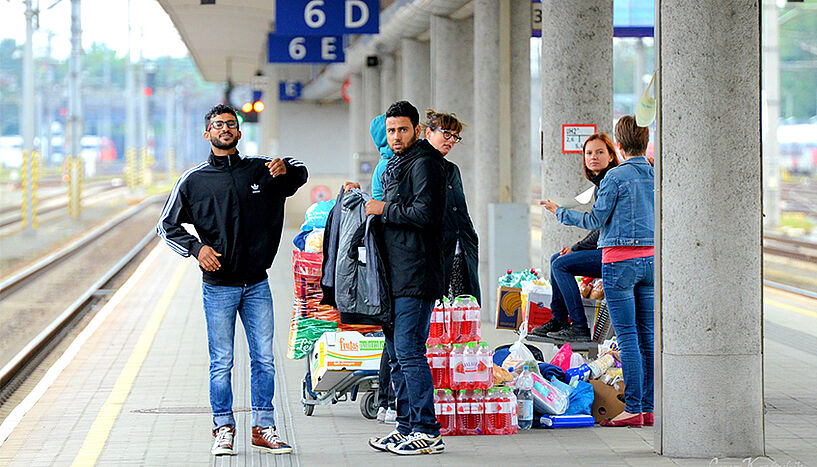Digital digging into the past
| 11. Januar 2017
In her work Tara Andrews combines her computer skills with medieval history and philology. (Foto: Universität Wien)
Combining computer programming skills and medieval history is daily routine for Tara Andrews, newly appointed professor for Digital Humanities at the University of Vienna. In this interview in response to the current Semester Question she gives insight into her work.
uni:view: You are the first professor in the field of Digital Humanities at the University of Vienna. Can you explain this new research area shortly?
Tara Andrews: We use computer technology to dig into the past, for example to do statistical analysis on manuscripts to discover their copying history. There are methods that are shared to some extent with evolutionary biology and with linguistics. We make statistical calculations that would be practically impossible to do by hand. So, for example, you have a DNA sequence or a sequence of words in a manuscript and you can kind of treat them similarly. Wherever these sequences differ across organisms or across texts, you can note these differences and do a calculation to come up with an evolutionary tree that would require the fewest mutations either of species or of manuscripts.
uni:view: The history of Digital Humanities cannot be that long. Can you give a short overview?
Andrews: It goes back to the 1940s and tends to start with a Jesuit priest called Roberto Busa, who was working on a concordance of the work of Thomas Aquinas. A concordance is an enormous list of words that we use in a work and the context in which they appear. Busa wanted a concordance so that he could study the concept of place in Thomas Aquinas' work, looking for all the words relevant to a sense of place. So in 1947 he actually went to IBM to have a meeting with Thomas Watson and somehow persuaded Watson to support a pilot project where he would use these new electronic computers for making the concordance. In the 1970s the Volumes appeared. It had taken him 20 years to do this by computer, but at the same time of course computer technology was busy evolving as Busa was doing his work. So the concordance was the first step, at least in the Digital Humanities in literature.
And then in the 1960s they started to use computers for authorship attribution. Then things started taking off from there, the 70s had a lot of vocabulary studies on the basis of all these digitized texts, the 80s had personal computers and so suddenly everybody was typing in their texts more easily. That's when you started to have organizations like the Text Encoding Initiative (TEI) to take all this transcription work people were doing and impose some order and sanity on it. The TEI is still going to this day. Then of course the internet came along in the early 90s and everything got everywhere, the field has been evolving like that ever since.
uni:view: How digital are the Humanities at the University of Vienna already?
Andrews: I'm in the process of finding this out! An Austrian Centre for Digital Humanities was set up at the Academy in 2015, and I know that they are involved in several projects together with people at the university, not only in history but also in German literature and other fields. Even where there are not yet digital projects, there is a lot of interest—I know of two monthly events, a "Stammtisch" and a round table, that were organized even before I arrived here.
uni:view: How do you personally apply digitalization in your research?
Andrews: My interest lies mostly in medieval Near Eastern Studies, particularly in medieval Armenia. And I have a background as a computer programmer. So when I came to the field of humanities I was quite naturally pushed towards the question: How can you use your computer programming skills to do interesting things in medieval history?
One example is digital prosopography. That is the study of individual people within the historical sources. So you have a bunch of sources, whether written histories, documents or gravestones, and you make a record of each individual person where they appeared in the different sources. Then you can trace that out on a map, you can even map a hundred people and watch their movements.
uni:view: You started out you education as a student at MIT, then you changed to humanities. Why so?
Andrews: I had been an exchange student in Greece as an undergraduate and this was when I learned that there was a place where the Middle Ages weren't completely depressing, and so I got really interested in Byzantine history. So when I came back I changed my major, which had been computer science, and spent my final year just taking history classes and graduated with this hybrid degree that was an option at MIT, knowing that I was going to be working in a dot.com company somewhere because that's what you did in 1999. Three years later when the dot.com went bust and I needed something to do then I thought well, why don't I get that degree in Byzantine history. And I did.
uni:view: Coming to your present research. What are you working on at the moment?
Andrews: I have a project to create a digital critical text edition of the 12th century history of Matthew of Edessa. The text is important because it was written by an Armenian Christian who was there when the First Crusade came through. The project is partially about the history he is writing about, understanding the text and tying it to the databases of historical geography and digital prosopographies that are already out there, when places or people appear in the text. On the other hand it is also a project about how you do digital modelling of a complex text. This text is complex because it survived in 35 copies and so part of the work of creating the edition is looking at the 35 copies and comparing them very closely. So I go the reconstructionist road and try to find the archetype of the text if I can. All of this is based on a new kind of tool called a graph database, which is helping me a lot.
Imagine the text as a great long line, one word after another. Now imagine that each manuscript copy has its own line of words, and you superimpose them. Every time one of the manuscripts reads differently from the others the line splits, and it comes back together when the manuscripts agree again. From this you can get a graph. When the graph gets wide, then the versions of text in the manuscripts were just all over the place compared to each other, and when it gets narrow again they all agree. With our graph database, we can come up with these kinds of network models and put them straight into the database.
uni:view: Going a bit broader coming to the end: Where do you see digitalization in the future?
Andrews: The trouble with working in technology is, it's so easy to see how wrong we were five years ago about where we will be in five years. I try hard never to make predictions.
The thing that is most worrisome for society in a way is that as all this information goes online it doesn't get forgotten.
There will be something that you did 20 years ago that you would have long forgotten, and that should lie very much in the past, but is suddenly appearing again. One thing that I am thinking of is this facial recognition technology that Facebook and others are working on. So some Japanese tourist is putting a scan of photos from 15 years ago online, and there you are, identified somewhere on a beach in Mexico. And you had no idea that your picture was being taken. It's sort of scary the things that can be illuminated, when it never occurred to anyone that it would come to light.
This can be useful for historians, of course! You do something you normally do in the Middle Ages, maybe copying a manuscript or building a ship, using some kind of material. And then cut to 500 years later, and we have instruments that can do all sorts of infrared or UV scans on the material you used and see the mistakes that you made, that nobody would have ever noticed with their bare eyes. Of course the people who made the mistake are long dead, so the ethical considerations are different. This kind of technology is a double edged sword, it's interesting for us but at the same time a bit scary.
uni:view: Thank you for the interview! (td)
About Tara Andrews:
Born in the USA, Tara Andrews did her Bachelor of Science in Humanities and Engineering at the Massachusetts Institute of Technology (MIT) in 1999, followed by a Master of Philosophy in Byzantine Studies at the University of Oxford, UK, in 2005. In 2009 she finished her Doctor of Philosophy in Oriental Studies at the University of Oxford, UK. From 2010 to 2013 she was a post-doctoral researcher in Greek Studies, KU Leuven, Belgium. From 2013 to 2016 she worked as an Assistant Professor of Digital Humanities at the University of Bern, Switzerland. Since September 2016 she is Professor of Digital Humanities at the Department of History at the University of Vienna.




